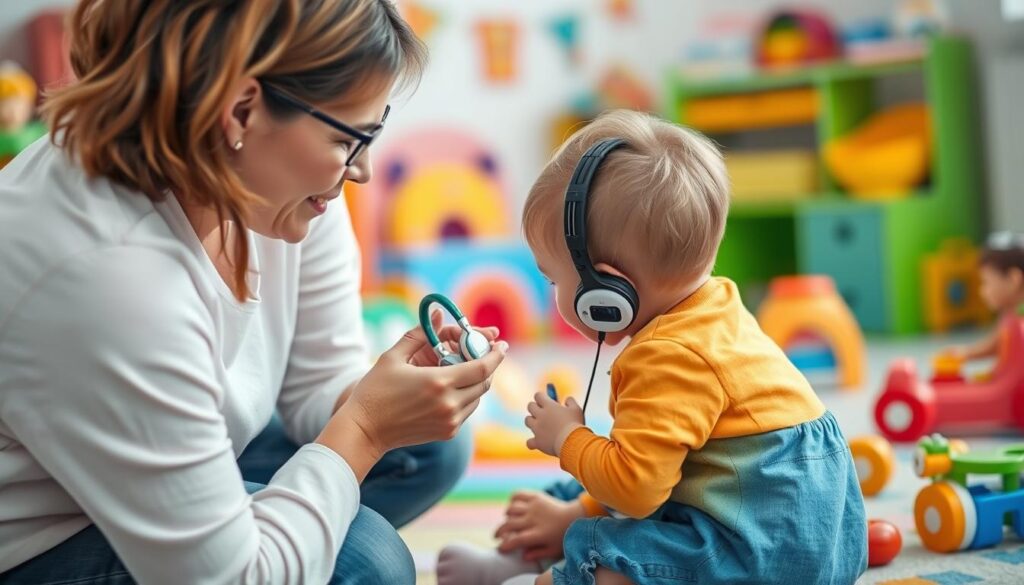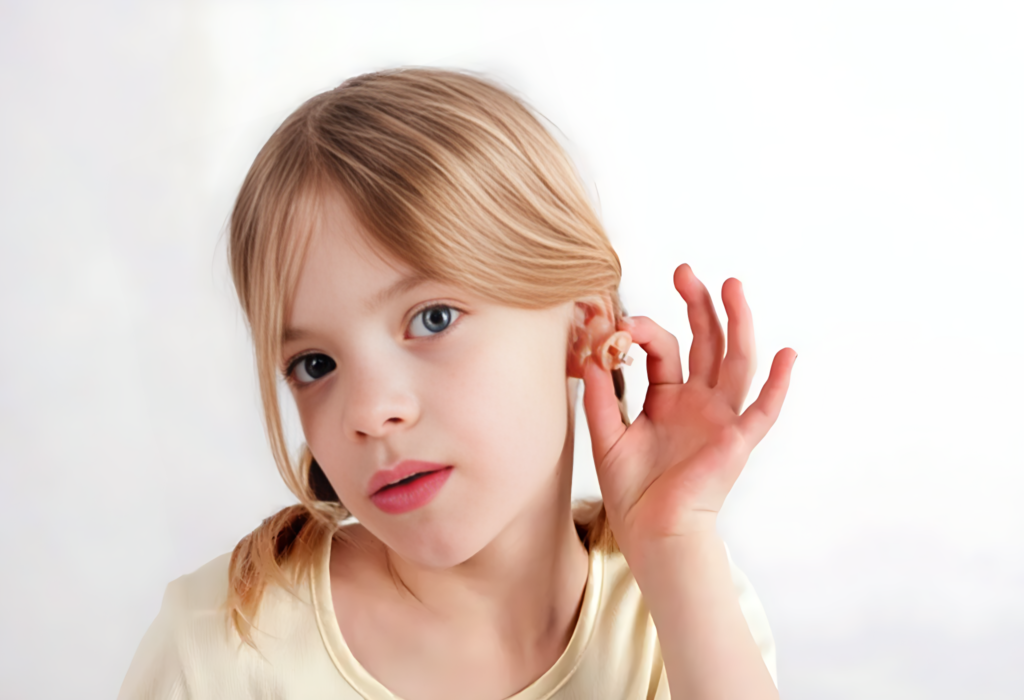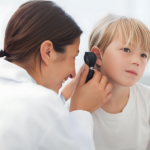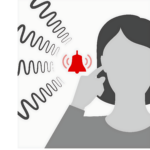Hearing Problems 5 Year Old: Signs, Causes, and Easy Fixes for Your Child’s Hearing Issues. You’ll learn how to help your child hear better and stay healthy.
If you’re looking for a solution to tinnitus, which can cause issues like whooshing, buzzing, or clicking in the ears, check out this affiliate link for a product that promises 20/20 hearing and better brain function.
Key Takeaways
- Spotting early signs of hearing loss in young kids is key to acting fast.
- Knowing what your child should be doing at their age can help spot hearing issues early.
- Getting a full hearing check from an audiologist is vital for finding out what’s wrong and fixing it.
- Looking into hearing aids and other tools can really help a child hear and talk better.
- Helping your child feel supported in school can help them succeed, even with hearing challenges.
Signs of Hearing Loss in Young Children
Potential Indicators to Watch For
Hearing loss in young children might not be easy to spot. As a parent or caregiver, knowing the signs is key. Look for a lack of reaction to loud sounds, trouble finding where a sound is coming from, and less babbling or talking. Also, check for any odd shapes or sizes in the ears.
Even a little hearing loss can hurt a child’s ability to speak and understand language. Some hearing problems are there from birth or start later in childhood. This can be because of genes.
Other hearing issues come from problems with the outer or middle ear. These can happen in young kids due to ear shape or middle ear problems. Finding these problems early is very important. It helps kids learn to talk and grow up better.
| Potential Hearing Loss Indicators | Description |
|---|---|
| Lack of reaction to loud sounds | A child who does not startle or respond to unexpected loud noises may be experiencing hearing problems. |
| Difficulty localizing sound sources | Children with hearing issues may struggle to determine the direction of a sound, such as a parent’s voice or a toy making noise. |
| Reduced babbling or speech development | Delayed or absent speech development can be a crucial sign of possible hearing loss in infants and young children. |
| Ear abnormalities | Structural abnormalities in the outer ear canal or middle ear can cause conductive hearing loss in children. |
If you see any of these signs in your child, get them checked by a doctor. They will send your child to see an audiologist. Early help is key for your child’s speech, language, and growth.For adults experiencing tinnitus or hearing loss, check out this affiliate link for a solution.
Understanding Hearing and Speech Development Milestones
It’s important to watch your child’s hearing and speech growth closely. From birth to 5 years, there are key milestones to look out for. These milestones help spot any issues early and offer the right support. Knowing these stages helps you support your child’s communication and tackle any hearing problems or speech delays.
Babies start to make sounds and recognize voices in the first 6 months. By 12-17 months, they say their first words like “ma-ma” or “da-da.” Around 18-23 months, they know about 50 words and use 3-word sentences.
- 2-3 years: Uses 3-word sentences and answers simple questions.
- 3-4 years: Uses most speech sounds, describes the use of objects, and uses verbs ending in “ing”.
- 4-5 years: Understands spatial concepts, speech is understandable, and they can describe how to do things.
- 5 years: Understands time sequences, engages in conversation, and uses sentences that are 8 or more words long.
Every child grows at their own pace. These milestones are just a guide. If you’re worried about your child’s hearing or speech, get help early. Early action can greatly help your child’s development.
| Age | Hearing and Speech Milestones |
|---|---|
| Birth to 5 months | Coos, vocalizes pleasure and displeasure sounds differently (laughs, giggles, cries, or fusses) |
| 6 to 11 months | Understands “no-no”, babbles (says “ba-ba-ba”), says “ma-ma” or “da-da” without meaning |
| 12 to 17 months | Vocabulary of four to six words |
| 18 to 23 months | Vocabulary of 50 words |
The first 3 years are critical for learning speech and language. By keeping up with your child’s progress, you support their communication skills fully.
“Early intervention can make a significant difference in helping your child reach their full potential.”For those dealing with hearing issues themselves, consider exploring this affiliate link, which offers a product designed to improve hearing and brain function.
Diagnosis and Testing for Hearing Problems 5 year old
If you think your 5-year-old might have hearing problems, there are tests to find out why. Finding and fixing hearing issues early is key for your child’s speech, language, and thinking skills.
Evaluations to Identify Hearing Issues
The first step is usually a check-up by a doctor, like a pediatrician or audiologist. They look for any ear problems and do simple tests, like using a tuning fork.
For more detailed checks, your child might have:
- Tympanometry: This test looks at the eardrum and middle ear bones for any issues.
- Otoacoustic Emissions (OAE) Test: It checks how the inner ear reacts to sound, showing if hearing is working right.
- Auditory Brainstem Response (ABR) Test: This test sees how the brain responds to sound, helping understand the hearing pathway.
These tests, done by a hearing expert, can show what kind of hearing problem your child has. They can find out if it’s conductive, sensorineural, or mixed.If you or someone you know struggles with hearing issues, consider visiting this affiliate link for a proven solution to tinnitus and hearing loss.

Knowing about these tests helps parents get the right help for their child. It’s important to catch hearing problems adults, hearing problems in young adults, and other hearing problems early.
Treatment Options for Childhood Hearing Loss
If your child has hearing problems, it’s crucial to look into treatment options. There are many ways to help, from removing earwax to using hearing aids. These methods can improve your child’s hearing and how they communicate.
First, doctors might remove earwax to fix hearing loss. This simple step can often fix the problem. But for more serious issues, other treatments are needed.
Depending on your child’s hearing loss, doctors might suggest several treatments:
- Hearing aids: These devices make sounds louder, helping your child hear better. They come in different styles and can be tailored to fit your child’s needs.
- Cochlear implants: For severe hearing loss, a cochlear implant might be suggested. It’s implanted and helps the child hear by stimulating the auditory nerve.
- Bone-anchored hearing aids (BAHAs): These are for children with certain types of hearing loss. They work by sending sound through the bone instead of the ear canal.
- Surgical interventions: Sometimes, surgery is needed to fix the cause of hearing loss. This could be to repair a hole in the eardrum or remove blockages.
It’s vital to work with your child’s ENT and audiologist to find the best treatment. With the right help, many children can greatly improve their hearing and communication skills.
“Early intervention is key when it comes to addressing childhood hearing loss. The sooner we can identify and treat the problem, the better the outcomes for the child’s speech, language, and overall development.”If you’re seeking an effective solution for tinnitus or hearing loss, this affiliate link can provide the help you need.
– Dr. Sarah Watson, Pediatric Audiologist
Creating an Optimal Learning Environment
For kids with ear hearing problems, newborn hearing problems, or common hearing problems, the classroom matters a lot. It can really help or hurt their learning. Teachers can make a big difference by setting up a great classroom for kids with hearing problems in noisy environments or hearing problems after epidural.
Making the classroom quieter is a good start. Closing the door helps block out outside noise. Using FM systems lets kids with hearing problems ms hear the teacher better. Also, having a special plan for each student helps them get the help they need.
Teachers should use methods that help kids with hearing issues. Giving kids lots of chances to learn new words and ideas is key. Encouraging them to watch and listen, and checking if they understand, helps a lot.
- Close the classroom door to improve acoustics
- Consider using an FM system to help with hearing in noisy environments
- Ensure students with hearing loss are on an appropriate educational plan
- Employ teaching strategies that support visual and auditory learning
- Offer multiple opportunities for students to hear and understand information
- Incorporate supplemental visuals to support auditory information
- Regularly check for student comprehension
By making the classroom better, teachers can help kids with hearing issues do well in school. With the right help, these kids can overcome challenges and achieve their goals.If you’re experiencing tinnitus or other hearing problems, explore this affiliate link for a solution that promises to improve hearing and brain function.
“Only 44% of hearing-impaired children leave school with two or more A Levels, highlighting the importance of providing a supportive and inclusive learning environment.”
Check out This Post: https://healthsuccesful.com/choosing-the-right-ear-protection-for-concerts-and-events/
Conclusion
This article has covered the signs, causes, and treatment options for hearing issues in 5-year-olds. Spotting the early signs—such as delayed speech or difficulty hearing in noisy environments—allows parents and educators to provide timely support. With the right interventions, whether it’s hearing aids, cochlear implants, or tailored classroom strategies, children with hearing problems can thrive.
Remember, addressing hearing issues early is crucial for your child’s development. Whether it’s understanding common causes like ear infections or considering treatments such as hearing aids, taking prompt action is vital. And for those experiencing tinnitus or seeking enhanced hearing, this affiliate link offers a product designed to improve hearing and brain function, helping you or your loved ones enjoy a fuller, sound-filled life.
FAQ
What are the potential indicators of hearing loss in young children?
Signs of hearing loss in young kids include not reacting to loud sounds. They might also have trouble finding where sounds come from. Other signs are less babbling or talking, and visible ear problems.
What are the typical developmental milestones for hearing and speech in young children?
From birth to 2 years, kids should start to know their caregiver’s voice. They should also notice changes in tone and say their first words.
What types of diagnostic tests may be recommended for suspected hearing problems in 5-year-olds?
Tests for hearing issues in 5-year-olds might include physical checks and screening tests. They might also have tuning fork tests and detailed audiometric evaluations by experts.
What treatment options are available for childhood hearing loss?
Treatments for hearing loss in kids include removing earwax and surgery. They might also use hearing aids or cochlear implants, based on their needs.
How can educators create an optimal learning environment for children with hearing problems?
Teachers can improve classroom sound by using better speakers and sound systems. They should also use assistive tech like FM systems. Making sure kids have the right educational plans helps them learn and grow.
Source Links
- Signs and Symptoms of Hearing Loss in Children | Cochlear – https://www.cochlear.com/us/en/home/diagnosis-and-treatment/diagnosing-hearing-loss/signs-of-hearing-loss-in-children
- Hearing Problems – http://www.bcchildrens.ca/health-info/coping-support/hearing-problems
- Hearing Loss in Children – https://www.healthychildren.org/English/health-issues/conditions/ear-nose-throat/Pages/Hearing-Loss.aspx
- 10 Clues Your Child Has a Hearing Loss — Hearing Health Foundation – https://hearinghealthfoundation.org/blogs/10-clues-your-child-has-a-hearing-loss
- Age-Appropriate Speech and Language Milestones – https://www.stanfordchildrens.org/en/topic/default?id=age-appropriate-speech-and-language-milestones-90-P02170
- Hearing Developmental Milestones Checklist – https://www.nationwidechildrens.org/specialties/hearing-program/speech-services-for-hearing-loss/hearing-developmental-milestones-checklist
- Speech and Language Developmental Milestones – https://www.nidcd.nih.gov/health/speech-and-language
- Hearing Tests for Children: MedlinePlus Medical Test – https://medlineplus.gov/lab-tests/hearing-tests-for-children/
- Hearing Tests (for Parents) – https://kidshealth.org/en/parents/hear.html
- Hearing Problems in 5 year olds | Blog | South Florida ENT Associates – https://www.sfenta.org/blog/hearing-problems-in-5-year-olds/
- Hearing Loss in Children – https://www.hopkinsmedicine.org/health/conditions-and-diseases/hearing-loss/hearing-loss-in-children
- Pediatric Hearing Loss – StatPearls – https://www.ncbi.nlm.nih.gov/books/NBK538285/
- Children With Hearing Loss: Guidelines for Schools – https://www.nationwidechildrens.org/family-resources-education/health-wellness-and-safety-resources/helping-hands/children-with-hearing-loss-guidelines-for-schools
- Classroom Accommodations for Children with Hearing Loss – https://www.stacycrouse.com/post/classroom-accommodations-for-children-with-hearing-loss
- How to support a child with a hearing impairment in school – Engage Education – http://engage-education.com/blog/how-to-support-a-child-with-a-hearing-impairment-in-school/
- Hearing Loss in Children: A Review – https://www.audiology.org/wp-content/uploads/legacy/jama_lieu_2020_review article.pdf
- Psychosocial Development of 5-year-old Children with Hearing Loss: Risks and protective factors – https://www.ncbi.nlm.nih.gov/pmc/articles/PMC5316508/
- Frontiers | Trajectory of hearing loss in children with unilateral hearing loss – https://www.frontiersin.org/journals/pediatrics/articles/10.3389/fped.2023.1149477/full



